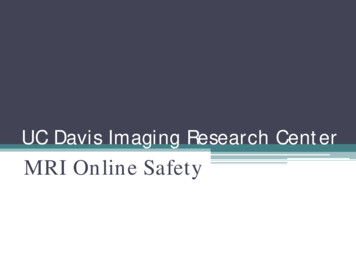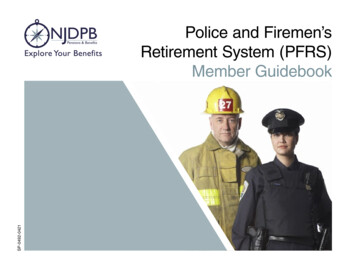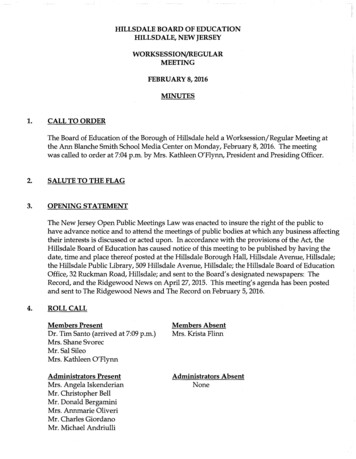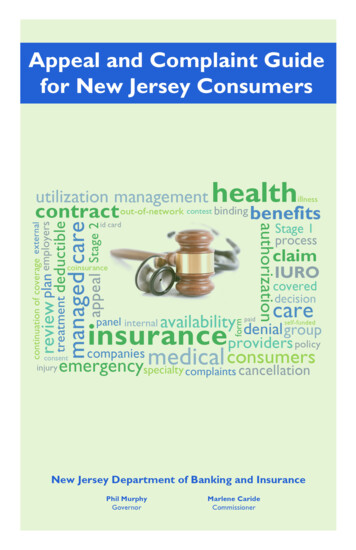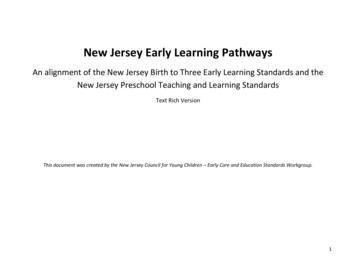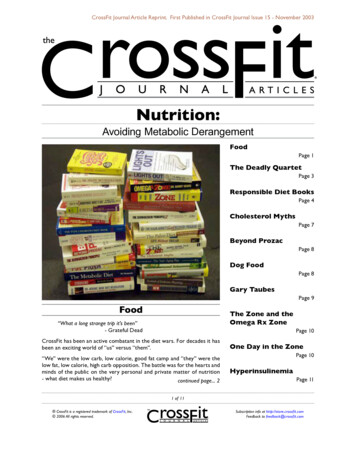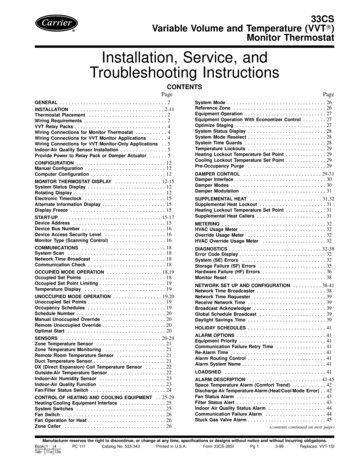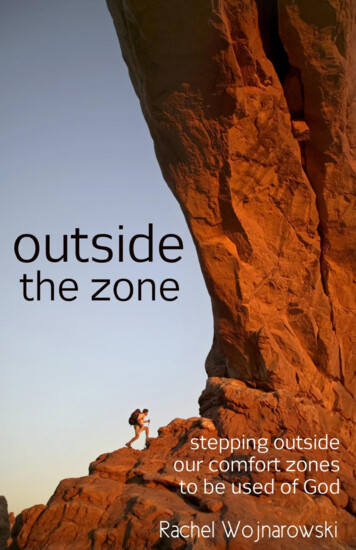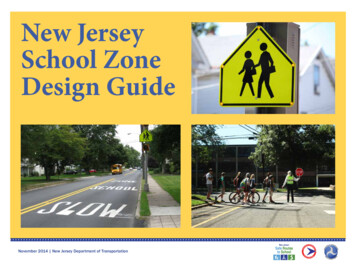
Transcription
New JerseySchool ZoneDesign Guide3 57(1 2) 75 163257 (',&Y,781STEATERSOF NEW JE70'(DEPAROR1,2 7THEOF TRANSPNNovember 2014 New Jersey Department of TransportationTENTIOTATM0 67 7(6 2) (5
New Jersey School Zone Design GuidePrepared for:The New JerseyDepartment of TransportationPrepared by:The RBA GroupFitzgerald & Halliday, Inc.November 2014(' 2) 75 163257 ,77(1,&Y7081STEATERSOF NEW JE'(3 5OR1,2 7DEPAROF TRANSPNETHNJ School Zone Design GuideTENTIOTAiTM0 67 7(6 2) (5
DisclaimerThis Design Guide has been prepared to provide information on engineeringmeasures and treatments that can be utilized to enhance pedestrian andbicyclist accommodations to, from and around schools. This publicationdoes not constitute a standard, specification, or regulation, and is notintended as a comprehensive reference for all aspects of student pedestrianand bicycle safety.The inclusion of measures in this report should not be considered asjustification for their inclusion at any specific location. Their application, aswith any traffic control devices, is dependent upon site-specific conditionsand engineering judgment.This publication has been financed with federal funds provided by the UnitedStates Department of Transportation’s Federal Highway Administration asadministered by the New Jersey Department of Transportation (NJDOT).The United States Government assumes no liability for its contents or its usethereof.(' 2) 75 163257 ,77(1,&Y7081STEATERSOF NEW JE'(3 5OR1,2 7DEPAROF TRANSPNETHNJ School Zone Design GuideTENTIOTAiiTM0 67 7(6 2) (5
ContentsIncludes a discussion on the benefits of walking and bicycling to school and an overviewof the NJ SRTS Program.2What is a School Zone?Page 5Covers the definition of a school zone and includes a discussion of the statutes and lawsrelated to pedestrians, bicyclists and school area safety.3MUTCD Traffic Controlfor School AreasPage 17Sets forth standards and guidance for the use of school zone signage, pavementmarkings and related devices.4Determining Placementof Crossing GuardsPage 26Provides guidance on how to identify the locations where crossing guards are needed.5Crossing the StreetPage 40Focuses on intersection and midblock crossing improvements.6Along the StreetPage 47Focuses on the streetscape elements that enhance the pedestrian and bicyclistenvironment including sidewalks and bikeways that facilitate travel along the street.7Traffic CalmingPage 56Highlights the engineering techniques that have been proven to be effective in reducingvehicle speeds and volumes.8Students & BicyclingPage 72Discusses some ways that bicycling to school can be encouraged and made safer.9The School Site &School GroundsPage 85Presents the key pedestrian and bicycle safety elements of locating a well-designedschool site.10Crime Prevention throughEnvironmental DesignPage 94Discusses the potential to reduce the dangers associated with walking and biking to schoolthrough the careful design and manipulation of the physical environment of the school site.11Schools NearRailroad CrossingsPage 102Focuses on the unique concerns related to students crossing railroads on their way toand from school.12Schools NearHighway RampsPage 112Discusses the dangers pedestrians and bicyclists face crossing ramps and design solutionsto improve visibility, reduce vehicular speeds and reduce pedestrian and bicyclist exposure.13Maintenance &Other ImprovementsPage 117Includes a discussion of maintenance issues and provides examples of prioritization ofschool zones for municipal snow shoveling.14How to Start ImprovingYour School ZonePage 126Includes a discussion of the steps needed to improve the conditions for students walkingand biking to school.ORY70,781STEATERSOF NEW JE'(3 5OF TRANSP7(1(' 2) 75 1632571,2 7DEPARTENNETHNJ School Zone Design GuideTM Page 1,&Introduction and OverviewTIOTAiii10 67 7(6 2) (5
Chapter 1: Introductionand OverviewThe NJ School Zone Design Guide provides guidance for the community of people, governmentand schools involved in the effort to enable and encourage children, including those withdisabilities, to walk and bicycle to school.Purpose of the NJ School Zone Design GuideThis Guide is intended to be used as a resourcefor school boards, school administration,police, parents and engineers to advance thegoals of the NJ Safe Routes to School (SRTS)Program.The focus of the Design Guide is onengineering measures that can be utilizedto make the environment to, from andaround schools a place where children andtheir parents feel safe and want to walkand bicycle. Engineering measures includephysical improvements to the transportationinfrastructure in the vicinity of the schooland on school property that are intendedto improve access and safety for travel bywalking and bicycling and minimize conflictswith motorized traffic. They are typicallydesigned to address specific problems orneeds that have been identified and can rangefrom simple sidewalk replacement/repair tomore complex traffic calming devices, such asroundabouts or speed humps.The inclusion of engineering measures inthis guide does not necessarily mean theyshould be included in every school zone. Theirapplication, as with any traffic control devicesor design elements, is dependent upon sitespecific conditions and engineering judgment.The Design Guide is based on: the Federal Highway Administration’s 2009Manual on Uniform Traffic Control Devices(MUTCD), the American Association of State Highwayand Transportation Officials (AASHTO)Guide for the Development of BicycleFacilities, AASHTO Guide for the Planning, Design,and Operation of Pedestrian Facilities, National Center for Safe Routes to SchoolOnline Guide, and the National Center for Safe Routes toSchool and the Institute of TransportationEngineers (ITE) SRTS Briefing Sheets.Safe Routes to School (SRTS)The goals of the SRTS Program areto encourage more students to walkand bike to school where it is safeto do so and to improve the areaswhere it is not safe.Students crossing in Ridgewood, NJ.Image: The RBA Group(' 2) 75 163257 ,77(1,&Y7081STEATERSOF NEW JE'(3 5OR1,2 7DEPAROF TRANSPNETHNJ School Zone Design Guide Chaper 1: Introduction and OverviewTENTIOTA1TM0 67 7(6 2) (5
Health, Safety and TransportationBuilding an environment that supportschildren’s ability to walk or bicycle to schoolsafely achieves a wide range of benefits forstudents, the school and the community.These benefits include reduced traffic inthe vicinity of schools, improved air quality,creation of safer, calmer streets andneighborhoods, and increased physical activityamong students and families, contributing tohealthier lifestyles.Today, fewer children are walking andbicycling to school, and more children are atrisk of becoming overweight and obese thanchildren 30 years ago. The U.S. Departmentof Health and Human Services recommendsthat children engage in 60 minutes or moreof physical activity each day and that the bulkof this physical activity comes through aerobicexercise. By walking or bicycling to school,children can easily incorporate exercise intotheir day and increase their overall physicalactivity. Children who walk one mile to andfrom school each day get approximatelytwo-thirds of the recommended level ofsixty minutes of physical activity a day. Plus,research shows that children who walk toschool have higher levels of physical activitythroughout the day and are more likely to getthe full sixty minutes of activity in a day.The 5 EsNot only does regular physical activity reduceobesity, it also helps build and maintainhealthy bones and muscles, reduces feelingsof depression and anxiety and ch shows that active children tend tohave better academic achievement, enhancedconcentration, and better classroombehavior.1Many children do not currently walk orbike to school due to safety concerns. Thisguide is intended to assist communities inidentifying and developing solutions to thosesafety concerns. Proper design and focus onthe school zone through the SRTS programcan lead to a decrease in the number ofpediatric pedestrian injuries for school-agedchildren. A safety analysis by the CaliforniaDepartment of Transportation estimates thatthe safety benefit of SRTS included up to a 49percent decrease in the childhood bicycle andpedestrian collision rates.2 In NJ, the SRTSprogram is centered around a comprehensive5E approach to ensure that school zones arenot only designed to be self-enforcing but thatchildren are also given the proper educationaltools to cultivate their pedestrian and bicyclingskill sets in order to help them eventuallynavigate the way to school on their own.The SRTS Program is organizedaround five complementary strategiesknown as the five Es. They are:1. Engineering:Makingtheenvironment safer for walkingand bicycling2. Encouragement:Encouragingkids to walk and bike to schoolmore often3. Education: Teaching kids andparents safe ways to walk and bike4. Enforcement: Changing driver,walker and bicyclist behavior asthey travel together along the road5. Evaluation: Checking to see howmany kids are walking and bikingas a result of the program or howconditions have improvedProjects that incorporate all five Esare likely to be more effective andsustainable.Centers for Disease Control and Prevention, “Health and Academic Achievement” (05/2014). www.cdc.gov/healthyyouth/health and academics/pdf/health-academic-achievement.pdfMarla Orenstein, Nicolas Gutierrez, Thomas Rice, Jill Cooper, and David Ragland, “Safe Routes to School Safety and Mobility Analysis” (April 1, 2007). UC Berkeley Traffic Safety Center.Paper UCB-TSC-RR-2007-112(' 2) 75 163257 ,77(1,&Y7081STEATERSOF NEW JE'(3 5OR1,2 7DEPAROF TRANSPNETHNJ School Zone Design Guide Chaper 1: Introduction and OverviewTENTIOTA2TM0 67 7(6 2) (5
NJ SRTS OverviewHistory of the NJ SRTS ProgramIn 2003, the New Jersey Department ofTransportation’s Office of Bicycle andPedestrianProgramsutilizedon-callconsultant support and a statewide TechnicalAdvisory Committee to develop a SRTSProgram. In 2004, NJDOT launched a series ofSRTS pilot demonstration programs in variedcommunity settings around the state. Atthe same time, the Department initiated theSafe Streets to School Program and in 2006,awarded approximately 5 million in statefunds to 60 infrastructure projects to improvesafety around schools.administered by the NJDOT, in partnershipwith the North Jersey Transportation PlanningAuthority (NJTPA), the Delaware ValleyRegional Planning Commission (DVRPC) andthe South Jersey Transportation PlanningOrganization (SJTPO).As of October 2014, NJDOT has awarded morethan 19 million in federal SRTS funds to 129projects at 212 schools in 98 communitiesacross New Jersey. Another 5 million hassupported these local projects with statewideprograms. More rounds of infrastructuregrants and educational programs are plannedSafe Routes to School was established as a to fulfill the goals of the Safe Routes to Schoolfederal program under the Safe, Accountable, Program.Flexible, Efficient Transportation Equity Act– A Legacy for Users (SAFETEA-LU) in 2005. How does the NJ SRTS Program work today?The NJDOT designated a full-time SRTS The overall SRTS program is overseen by theCoordinator, developed its first SRTS Strategic SRTS Coordinator in the NJDOT’s Office ofPlan and initiated a competitive grant program Bicycle and Pedestrian Programs. The SRTSto fund local and statewide engineering, Coordinator is responsible for monitoringenforcement, education and encouragement all aspects of the program. This includesprojects to enable elementary school children managing the non-infrastructure program,participating in the SRTS infrastructure grantto walk and bike to school safely.program solicitation and selection processIn 2012, Congress passed a new and helping to ensure that state and federaltransportation bill: Moving Ahead for Progress requirements are met. The federally fundedin the 21st Century (MAP-21). Under this SRTS grant program is administered bylegislation, SRTS has been combined NJDOT’s Division of Local Aid and Economicwith two other programs (Transportation Development. It is operated as a competitiveEnhancements and Recreational Trails) under grant program in which proposals fromthe Transportation Alternatives Program. applicants to develop and implementNJDOT has elected to continue SRTS as a infrastructure projects are solicited andstandalone federal-aid program. It is currently evaluated.Why develop accommodationsalong walking and bicyclingroutes to and from school? Improvements provide a saferenvironment for the wholecommunity — 24 hours a day, notjust before and after school. Walking and biking to schoolreduces the amount of greenhousegas emissions released as it reducesthe number of children that aredriven to school. Over time, bicycle and pedestrianimprovements can save tax dollars. Walking and bicycling are fun,healthy, non-polluting, friendly,educational, and economical!Walk to School Event in Tenafly, NJ. Image: VTC(' 2) 75 163257 ,77(1,&Y7081STEATERSOF NEW JE'(3 5OR1,2 7DEPAROF TRANSPNETHNJ School Zone Design Guide Chaper 1: Introduction and OverviewTENTIOTA3TM0 67 7(6 2) (5
The Alan M. Voorhees Transportation Center(VTC), working closely with NJDOT, operatesthe NJ Safe Routes to School Resource Center(NJ SRTSRC) which provides services, training,coordination, and technical assistance directlyto regional planning organizations, schoolsand school districts, and local and regionalgovernments.In 2011, NJDOT implemented the New JerseySafe Routes to School Non-InfrastructureTechnical Assistance Program. This programis a cooperative venture involving NewJersey’s eight Transportation ManagementAssociations (TMAs), the NJ SRTSRC andNJDOT. NJDOT provides federal funding,program administration and oversight; theNJ SRTSRC provides services, training,evaluation, and technical assistance toall eight NJ TMAs; and the SRTS RegionalCoordinators at each of the TMAs proactivelyreach out to schools, local governments andother organizations to provide them with avariety of SRTS non-infrastructure services.Services include assistance with pedestriansafety assemblies, bicycle rodeos, walkingschool buses and Walk and Bike to SchoolDay events.ResourcesNJDOT Safe Routes to School ProgramEmail: srts@dot.state.nj.usWebsite: www.state.nj.us/transportation/community/srts/New Jersey SRTS Resource CenterTelephone: 848-932-7901Email: srts@ejb.rutgers.eduWebsite: www.saferoutesnj.orgThe National Center for SRTSWebsite: www.saferoutesinfo.org/SRTS National PartnershipWebsite: www.saferoutespartnership.org/The Official Web Site of International Walk toSchoolWebsite: www.iwalktoschool.org/The USA Web Site for International Walk toSchool EventsWebsite: www.walkbiketoschool.org/Centers for Disease Control and Prevention(CDC) Kids Walk to SchoolFederal Highway Administration (FHWA) SRTS www.cdc.gov/nccdphp/dnpa/kidswalk/Website: www.fhwa.dot.gov/environment/safe routes to school/As part of this program, all New Jerseymunicipalities and K-8 schools are eligibleto receive free, non-construction relatedservices. TMAs are also charged withprioritizing disadvantaged communities intheir outreach efforts to allow for an equitabledistribution of services.(' 2) 75 163257 ,77(1,&Y7081STEATERSOF NEW JE'(3 5OR1,2 7DEPAROF TRANSPNETHNJ School Zone Design Guide Chaper 1: Introduction and OverviewTENTIOTA4TM0 67 7(6 2) (5
Chapter 2: What is aSchool Zone?There are generally three zones around the school one must think about when applyingsafety standards for walking and bicycling routes to school: the state statutory definition ofschool zone, the student catchment area or enrollment boundary, and the school walkingzone.What is a school zone?OR7(1(' 2) 75 1632571,2 7,781STEATERSOF NEW JE70 OF TRANSP,&TENNETHNJ School Zone Design Guide Chapter 2: What Are School ZonesTMTIOTA5The section of roadway adjacentto a school (one definition of aschool zone, as defined by NJ StateStatute) is shown in yellow above.'(3 52. Where school crossings have beenestablished in the vicinity of a school,upon which are maintained appropriate"school signs" in accordance withspecifications adopted by the chiefadministrator and in accordance with law."School crossing" means that portion of apublicly maintained roadway where schoolchildren are required to cross the roadwayin the vicinity of a school.DEPAR1. The section of roadway adjacent to aschool, or,The focus of this Design Guide is onengineering measures that can be utilizedto make the environment around schools aplace where children and their parents feelsafe and want to walk and bicycle. Becausethe first statutory definition is limited to thearea around the school and the secondstatutory definition is confined to crossings,both of these definitions of “school zone” aretoo restrictive for the purposes of this Guide.YThe State Statutory Definition of School ZoneTitle 39 of the New Jersey Statutes Annotated(N.J.S.A.) contains the laws that controlevery publicly maintained roadway, as wellas the majority of laws that govern bicycleand pedestrian matters. It also includes twodefinitions for “school zone.” N.J.S.A. 39:1-1describes a school zone as:0 67 7(6 2) (5
Student Catchment Area or EnrollmentBoundaryThe student catchment area or enrollmentboundary refers to the geographic area fromwhich students are eligible to attend a localschool. This area is the theoretical outsidelimit for a “school zone.” For schools with ageographically expansive catchment area,some students will live too far away fromschool to reasonably be expected to walkor bike. In addition, the growth of charterand magnet schools has made applying anenrollment boundary more difficult becausethese schools can typically draw fromanywhere within a school district. Therefore,the student catchment area, as a practicalmatter, and for the purposes of this designguide, could cover too much territory tofunction as the school zone.7(1(' 2) 75 163257 ,781STEATERSOF NEW JE70,&OR'(3 5OF TRANSP1,2 7DEPARTENNETHNJ School Zone Design Guide Chapter 2: What Are School ZonesTMTIOTA6Student Catchment Area orEnrollment Boundaryshown in red.School Walking Zonewith half-mile radiusshown in light orangeand one-mile radiusshown in darker orange.YSchool Walking ZoneThe concept of “school zone” that is the focusof this design guide is best described by theterm school walking zone. The school walkingzone can be defined as the area surroundinga school that includes the public rights of waythat are most frequently and intensively usedby students and others accessing the school,especially by walking or by bicycle. In thisdesign guide, unless otherwise specified, theterm “school zone” is synonymous with theterm “school walking zone.”0 67 7(6 2) (5
State law (N.J.S.A. 18A:39-1.5) requires school districts that providecourtesy busing to adopt a policy addressing the busing of studentswho walk along hazardous routes between their homes and schools.The policy must include a list of hazardous routes that require courtesybusing and the criteria used in designating the routes as hazardous. InNew Jersey, routes are considered hazardous based on criteria suchas high traffic volume, traffic speed, roads with blind curves or steepinclines and declines, lack of sidewalks, presence of bridges and traintracks, and busy roads or highways that must be crossed to reach theschool. School districts must work with municipal officials and policeofficers when designating a route hazardous.For more information visit, (1(' 2) 75 1632571,2 7,781STEATERSOF NEW JE70 OR,&OF TRANSP'(3 5TENNETHNJ School Zone Design Guide Chapter 2: What Are School ZonesTMTIOTA7New Jersey Administrative Code (N.J.A.C) 6A:27 sets forth the rulesgoverning the transportation of students to and from school. A schooldistrict is required to provide busing only to those students who livemore than 2 miles from their public elementary and middle schoolsand more than 2.5 miles from their public high schools and to certainspecial education students. Boards of education are not required by lawto provide busing for students who live less than remote from schooleven for safety reasons. However, many districts have opted to busstudents who live below these distance thresholds, a service known as“courtesy” busing or non-mandated busing. Some school districts helpdefray the cost of courtesy busing by charging the student’s parentsor legal guardians for this service. Municipalities may also contractwith boards of education for this service and charge the parents. Thistransportation service is called “subscription” busing.DEPARFor this design guide, the term school zone or schoolwalking zone refers to the area within approximately aone-mile radius of a school – a distance easily covered bymost elementary students on foot or bike. This area shouldbe adjusted as needed to take into account local conditions,such as the extent of the school catchment area, trafficconditions, geographic constraints and other local concerns.During the course of determining the school walking zone, itis likely that conditions that are problematic to pedestriansand bicyclists will be discovered which may need to beremedied by applying the design guidance contained in thisdocument.School BusingYSchool walking zones vary in size depending on localpolicies, context and the student enrollment boundary.While there is no established definition of a school walkingzone, a number of sources provide guidance regarding theextent of a school walking zone. Under the FHWA program guidance for the federal SafeRoutes to School (SRTS) funding program, projects andactivities must be located or take place within two milesof a primary or middle school (grades K – 8). Also suggestive is the fact that New Jersey law doesnot require and the state does not provide funding tobus public school students that live within two miles ofschool. The MUTCD defines a school zone as “a designatedroadway segment approaching, adjacent to and beyondschool buildings or grounds, or along which schoolrelated activities occur.” The NJ SRTS Resource Center recommends a schoolwalking zone covering the area within at least one halfmile of the school. The National Center for Safe Routes to School generalrule of thumb is that the walking boundary is one halfmile to one mile around an elementary school, andsometimes further for middle and high schools.0 67 7(6 2) (5
7(1(' 2) 75 1632571,2 7,781STEATERSOF NEW JE70 OR,&OF TRANSP'(3 5TENNETHNJ School Zone Design Guide Chapter 2: What Are School ZonesTMTIOTA8Image: The RBA GroupThe speed limit in NJ, unless otherwiseposted, is 25 mph when passing through aschool zone (N.J.S.A. 39:4-98). Therefore,many school speed limit zones may be asshort at 400 ft. However, the beginningand end points of a school speed limitzone should be determined based on thelocation of other traffic control devices,features and locations where childrencross the roadway.DEPARSchool zones, as defined by New Jerseystatute, do not need to be adopted bymunicipal ordinance or resolution; however,designated school crossings can be adoptedby municipal ordinance or resolution. Amunicipality may choose to designatecrossings as school crossings where specialNJDOT has adopted the federal Manualon Uniform Traffic Control Devices(MUTCD) for rules and regulationsconcerning the placing, specification,location and maintenance of highwayand traffic signs and markings (N.J.S.A.3:4-183.27). According to the 2009MUTCD, the beginning point of a reducedschool speed limit zone should be at least200 feet in advance of the school grounds,a school crossing, or other school relatedactivities; however, this 200-foot distanceshould be increased if the reduced schoolspeed limit is 30 mph or higher (MUTCDSection 7B.15).Yemphasis is needed due to a combinationof the number of crossing school children,geometry of the approaching roadways,No, there is no relationship. Drug-Free / approach speed, and traffic volumes. SpecialDrunk-Driving Free / Smoke-Free School emphasis could include placement of an adultZones include the areas on or within 1,000 school crossing guard, installing signage,feet of property used for school purposes and pavement markings or a signal.which is owned or leased to any elementaryor secondary school or school board. AnyDrug-Free / Drunk-Driving Free / Smoke- How is a reduced school speed zoneFree School Zone map must be created designated?and adopted by the municipality. The map A reduced speed zone is designated throughis intended to be used as evidence in signing supplemented with striping. A schoolprosecutions arising under the criminal laws zone should be marked with special signingof the state (N.J.S.A. 2C:35-7).to alert drivers of the high concentrationof children. School crossing signs, speedsigns, and school zone pavement markingsHow do you designate a school zone?remind drivers to treat the area with specialDesignating a school zone or school walking care and attention.zone is accomplished by local action, oftenon an ad hoc basis by, for example, a SRTSworking group as part of the process ofdeveloping a SRTS Travel Plan. School zoneboundaries can be formalized by the schoolboard or a municipality by formal adoption ofthe SRTS Travel Plan or by ordinance.Is there any relationship between a drugfree, drunk-driving free or smoke-free schoolzone and a school walking zone?Where should the school speedlimit zone begin and end?0 67 7(6 2) (5
What is the school zone speed limit? Whodetermines the speed limit?Establishing and enforcing the proper schoolzone speed limit is critically important. Thespeed limit in New Jersey, unless otherwiseposted, is 25 miles per hour (mph) whenpassing through a school zone during recess,when the presence of children is clearlyvisible from the roadway, or while children aregoing to or leaving school, during opening orclosing hours (N.J.S.A. 39:4-98). Because itis established by statute, a 25 mph schoolzone speed limit does not require adoption ofan ordinance and approval from NJDOT.Hoboken’s 20 is Plenty CampaignIn October 2010, the City of Hoboken launched a“Twenty is Plenty” driving and pedestrian safety publicawareness campaign to encourage drivers to considerdriving no faster than 20 mph despite the 25 mphspeed limit on most Hoboken streets. The campaignwas inspired by the “20’s Plenty for Us” effort startedin Britain. Hoboken promoted the Twenty is Plentyeffort through newspapers, flyers at the Parking Utility,and with electronic signs at major inbound streets.Why is driving 20 mph so important?Driving just 5 mph slower can have a profound impact on the safety of pedestrians.However, not all school speed limit zones are25 mph. Local authorities, with referenceto roadways under their jurisdiction, mayby ordinance, or in the case of countyauthorities, by ordinance or resolution,designate a reasonable and safe speed limitthat is less than or greater than 25 mph afteran engineering and traffic investigation. Theestablishment of school speed limits shouldalways be done in coordination with theagency having jurisdiction over the roadway inquestion, particularly if the limits are less thanor greater than 25 mph [N.J.S.A. 39:4-98(c)].For more information on Hoboken’s “20 is Plenty”campaign visit ng/twenty-is-plenty/For more on England’s “20 is Plenty for Us” effort visit www.20splentyforus.org.uk/(' 2) 75 163257 ,77(1,&Y7081STEATERSOF NEW JE'(3 5OR1,2 7DEPAROF TRANSPNETHNJ School Zone Design Guide Chapter 2: What Are School ZonesTENTIOTA9TM0 67 7(6 2) (5
When does “when children are present” apply?What other traffic laws relate to school zones?“When children are present” does not applyat all times in a school zone. The SuperiorCourt of New Jersey has determined the lowerspeed limit in a school zone is only applicable(1) during school hours, but only duringrecess, when children are clearly visible fromthe roadway, or (2) when children are goingto or leaving school during opening or closinghours of school (State of New Jersey v. FloydA. Beierle (1999)).The reduced school zonespeed limit does not apply outside of thesetimes.Restricting parking in advance of crosswalks and corners improves visibility of the crossingfor both drivers and pedestrians. According to N.J.S.A 39:4-138, parking is not permitted: within an intersection; on a crosswalk; within 50 feet of a “stop” sign; or within 25 feet of the nearest crosswalk or side line of a street or intersecting highway orwithin 10 feet of the nearest crosswalk or side line of a street or intersecting highway, ifa curb extension or bulb-out has been constructed at that crosswalk.Regardless of the time of day or year, driversshould always be alert and on the lookoutfor children when driving near schools,parks or other attractions.7(1(' 2) 75 1632571,2 7,781STEATERSOF NEW JE70 OR,&OF TRANSP'(3 5TENNETHNJ School Zone Design Guide Chapter 2: What Are School ZonesTMTIOTA10The City of New Brunswick has begun installing plastic pylonsin the no-parking area, a practice called “daylighting.” Thecost of purchasing and installing the standard-use pylons isminimal and can be done in-house with little delay.Image: VTCDEPARAccording to N.J.S.A. 39:4-98, when designating reasonableand safe speed limits for a street under its jurisdiction, as partof an engineering and traffic investigation, a municipalityor county shall consider, but not be limited to, the followingcriteria: crash history; residential density; the presence, or lack,of sidewalks; the prevalence of entry and exit ways for businessand commercial establishments; whether school children walkadjacent to the street on their way to and from school; theproximity of recreational or park areas, schools, communityresidences, family day care homes, child care centers, ass
1 NJ School Zone Design Guide Chaper 1: Introduction and Overview Purpose of the NJ School Zone Design Guide This Guide is intended to be used as a resource for school boards, school administration, police, parents and engineers to advance the goals of the NJ Safe Routes to School (SRTS) Program. The focus of the Design Guide is on
